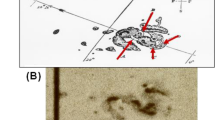Abstract
Spectroscopic astronomical instrumentation has much evolved in the last 40 years. Long-slit grating spectrographs with a photographic plate as the detector working in the 0.3–1 μm range were prevalent up to the early 1970s. The replacement of photographic plates by two-dimensional digital detectors provided gains in sensitivity of two orders of magnitude and much better photometric and radial velocity precision, and opened the 1 to 25 μm infrared domain. Another gain in speed by up to two orders of magnitude was then obtained through the development of various spectroscopic systems, each optimized for a subset of astronomical objects. This development was underpinned by a number of technological advances, in particular the development of automatic data reduction pipelines using sophisticated algorithms. With ever larger and more complex instrument systems for the present 8–10 m diameter telescopes—and soon even more for the next generation of Extremely Large Telescopes, the development of an instrument is now a big enterprise, ranging all the way from long-term enabling technology efforts to management of large teams for construction and deployment over typically 7–8 years.







Similar content being viewed by others
References
Adam, G., Bacon, R., Courtès, G., Georgelin, Y., Monnet, G., Pécontal, E.: Observations of the Einstein cross 2237+030 with the TIGER integral field spectrograph. A&A 208, L15–L18 (1989)
Allington-Smith, J.: Integral field spectroscopy for panoramic telescopes. RevMexAA (Serie de Conferencias) 28, 17 (2007)
Bacon, R.: Probing unexplored territories with muse: a second-generation instrument for the VLT. ESO Messenger 124, 5 (2006)
Bland-Hawthorn, J., McGrath, A.J., Saunders, W., Haynes, R., Gillingham, P.: Honeycomb: a concept for a programmable integral field spectrograph. Proc. SPIE 5492, 242 (2004). doi:10.1117/12.550291
Bland-Hawthorn, J., Horton, A.: Instruments without optics: an integrated photonic spectrograph. Proc. SPIE 6269, 21 (2006)
Buisson, H., Fabry, C., Bourget, H.: An application of interference to the study of the Orion nebula. Ap. J. 40, 241 (1914). doi:10.1086/142119
Butcher, H.: Multi-aperture spectroscopy at kitt-peak. Proc. SPIE 331, 296 (1982)
Cameron, M., Weitzel, L., Krabbe, A., Genzl, R., Drapatz, S.: 3D: the new MPE near-infrared field imaging spectrometer. B.A.A.S. 25, 1468C (1993)
Carranza, G., Courtès, G., Georgelin, Y., Monnet, G., Pourcelot, A.: Interferometric study of ionized hydrogen in M 33: new kinematical and physical data. Ann. Astrophys. (Paris) 31, 63 (1968)
Content, R.: New design for integral field spectroscopy with 8-m telescopes. Proc. SPIE. 2871, 1295 (1997). doi:10.1117/12.269020
Courtès, G.: An integral field spectrograph (IFS) for large telescopes. In: Humphries, C.M. (ed.) Instrumentation for Astronomy with Large Optical Telescopes, vol. 92, p. 123. Dordrecht, Reidel, ASSL (1982)
Ellis, S.C., Bland-Hawthorn, J.: The case for OH suppression at near-infrared wavelengths. Mon. Not. R. Astron. Soc. 386, 47 (2008). doi:10.1111/j.1365-2966.2008.13021.x
Flores, H., Puech, M., Hammer, F., Garrido, O., Hernandez, O.: GIRAFFE multiple integral field units at VLT: a unique tool to recover velocity fields of distant galaxies. A&A 420, L31–L34 (2004)
Hill, J.M., Angel, J.R.P., Scott, J.S., Lindley, D., Hintzen, P.: Multiple object spectroscopy - The Medusa spectrograph. Astrophys. J. 242, L69–L72 (1980). doi:10.1086/183405
Hill, G.J., MacQueen, P.J., Adams, J., Tufts, J., Blanc, G., Smith, M.P., Roth, M.M., Kelz, A., Segura, P., Gebhard, K., Good, J., Drory, N.: VIRUS-P: a powerful integral field spectrograph designed for replication. B.A.A.S. 39, 747 (2007)
LeCoarer, E., Blaize, S., Benech, P., Stefanon, I., Morand, A., Lérondel, G., Leblond, G., Kern, P., Fedeli, J.M., Royer, P.: Wavelength-scale stationary-wave integrated Fourier-transform spectrometry. Nature Photonics 1(8), 473 (2007)
Liller, W.: High dispersion stellar spectroscopy with an echelle grating. Appl. Opt. 9(10), 2332 (1970). doi:10.1364/AO.9.002332
Marcelin, M., Amram, P., Balard, P., Balkowski, C., Boissin, O., Boulesteix, J., Carignan, C., Daigle, O., de Denus Baillargeon, M.-M., Epinat, B., Gach, J.-L., Hernandez, O., Rigaud, F., Vallée, P.: 3D-NTT: a versatile integral field spectroimager for the NTT. SPIE Conf., vol. 7018. Marseille (2008)
Morris, S., Content, R., Sharples, R., Bower, R., Davies, R., Baugh, C.: A million element integral field unit (MEIFU). Proceedings of the ESO conference on scientific drivers for ESO future VLT/VLTI instrumentation, p. 99 (2002)
Perryman, M.A.C., Favata, F., Peacock, A., Rando, N., Taylor, B.G.: Optical STJ observations of the crab pulsar. A&A 346, L30 (1999)
Romani, R.W., Miller, A.J., Cabrera, B., Figueroa-Feliciano, E., Nam, S.W.: First astronomical application of a cryogenic transition edge sensor spectrophotometer. Astrophys. J. 521, L153–L156 (1999). doi:10.1086/312202
Simons, D., Clark, C.C., Smith, S., Ken, J., Massey, S., Maillard, J.P.: CFHT’s imaging Fourier transform spectrometer. Proc. SPIE. 2198, 185 (1994). doi:10.1117/12.176746
Tully, R.B.: The kinematics and dynamics of M51. 1. The observations. Astrophys. J. Suppl. Ser. 27, 415 (1974). doi:10.1086/190304
Vanderriest, C.: A fiber-optics dissector for spectroscopy of nebulosities around quasars and similar objects. PASP 92, 858 (Dec. 1980–Jan. 1981)
Weitzel, L., Krabbe, A., Kroker, H., Thatte, N., Tacconi-Garman, L.E., Cameron, M., Genzel, R.: 3D: The next generation near-infrared imaging spectrometer. A&AS 119, 531 (1996)
Wilkinson, A., Fosbury, R., Wallace, P., Sharples, R.: Stellar Dynamics of Cen A. B.A.A.S. 15, 921 (1983)
Acknowledgements
The author is deeply indebted to the many individuals and organizations which have fueled the rapid development of astronomical instrumentation in the four decades covered here. I would like to apologize for having been forced to skip many clever and highly useful innovations in the field for lack of space (and no doubt in some cases from lack of insight). I have tried hard to give proper credit to the pioneers but again would like to apologize in advance for any glaring mistake or omission.
Author information
Authors and Affiliations
Corresponding author
Rights and permissions
About this article
Cite this article
Monnet, G.J. Astronomical spectroscopy in the last four decades: survival of the fittest. Exp Astron 25, 91–106 (2009). https://doi.org/10.1007/s10686-009-9159-4
Received:
Accepted:
Published:
Issue Date:
DOI: https://doi.org/10.1007/s10686-009-9159-4




